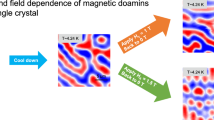Abstract
We have obtained an analytical expression for nuclear precession and nuclear echo signals generated in magnetically ordered materials upon resonant excitation of the nuclear subsystem by two pulses of identical amplitude but different durations. We show that in a nuclear subsystem with inhomogeneous broadening of the spectroscopic transition and an inhomogeneous gain distribution, the two-pulse precession and echo signals are split into four and nine components respectively. We have analytically established a correlation between the macroscopic parameters of the components of the two-pulse signals (relative amplitudes, signal formation times) and the microscopic parameters of the magnetically ordered media (inhomogeneous half-width of the spectral line, half-width of the gain distribution function, average gain). The theoretically calculated formation times for the components of the nuclear precession and nuclear echo signals agree with the experimental data obtained for the alloy FeNiCo (70% Co).
Similar content being viewed by others
References
V. S. Kuz’min and G. G. Fedoruk, Nonsteady-State Coherent Phenomena in Paramagnetic Spin Systems [in Russian], Bel. Gos. Univ., Minsk (2001).
V. M. Akulin and N. V. Karlov, Intense Resonant Interactions in Quantum Electronics [in Russian], Nauka, Moscow (1987).
M. I. Kurkin and E. A. Turov, NMR in Magnetically Ordered Materials and Its Application [in Russian], Nauka, Moscow (1990).
A. S. Borovik-Romanov, Yu. M. Bun’kov, B. S. Dumesh et al., Usp. Fiz. Nauk, 142, 537–570 (1984).
K. Steenbeck, T. Eich, K. Kirsch, K. O’Donnell, and E. Steinbeiss, Appl. Phys. Lett., 71, 968–970 (1997).
D. K. Fowler, D. C. Creagh, R. W. N. Kinnear, and G. V. H. Wilson, Phys. Status Solidi (a), 92, 545–553 (1985).
A. E. Reingardt, V. I. Tsifrinovich, O. V. Novoselov, and V. K. Mal’tsev, Fiz. Tverd. Tela, 25, 3163–3164 (1983).
V. N. Berzhanskii, S. V. Kapel’nitskii, V. S. Pokatilov, and S. N. Polulyakh, Fiz. Tverd. Tela, 44, 83–86 (2002).
V. O. Golub, V. V. Kotov, and A. N. Pogorelyi, Fiz. Tverd. Tela, 40, 1056–1061 (1998).
V. S. Kuz’min, I. Z. Rutkovskii, A. P. Saiko, A. D. Tarasevich, and G. G. Fedoruk, Zh. Éksp. Teor. Fiz., 97, 880–891 (1990).
V. S. Kuz’min and V. M. Kolesenko, Fiz. Tverd. Tela, 47, 1994–1997 (2005).
A. H. Nayfeh, Introduction to Perturbation Techniques [Russian translation], Mir, Moscow (1984).
Author information
Authors and Affiliations
Corresponding author
Additional information
__________
Translated from Zhurnal Prikladnoi Spektroskopii, Vol. 75, No. 4, pp. 529–538, July–August, 2008.
Rights and permissions
About this article
Cite this article
Kuz’min, V.S., Kolesenko, V.M. & Borbotko, E.P. Pulsed nuclear magnetic resonance signals in magnetically ordered materials. J Appl Spectrosc 75, 550–559 (2008). https://doi.org/10.1007/s10812-008-9075-9
Received:
Published:
Issue Date:
DOI: https://doi.org/10.1007/s10812-008-9075-9




